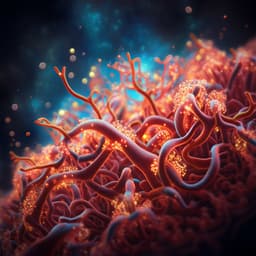
Medicine and Health
T-cells produce acidic niches in lymph nodes to suppress their own effector functions
H. Wu, V. Estrella, et al.
This groundbreaking research reveals how the acidic environment of tumors inhibits the function of activated CD8+ T-cells, suggesting a physiological mechanism in immune regulation. Conducted by leading experts in cancer immunology, the study uncovers the role of acidic niches in lymph nodes and their impact on T-cell metabolism and activation.
~3 min • Beginner • English
Introduction
The study investigates whether acidic microenvironments form within lymph nodes and how such acidity influences T-cell function. While acidosis is known to suppress effector T-cell functions in vitro and in solid tumors, its physiological relevance in lymph node (LN) biology has been unclear. LNs have low convective flow and high glucose metabolism, conditions that could favor extracellular acidification. The authors hypothesize that T-cells create acidic niches in LN paracortical zones, providing a negative-feedback mechanism that restrains effector functions without impairing initial T-cell activation, thereby contributing to immune regulation.
Literature Review
Prior work has demonstrated that low extracellular pH (acidosis) inhibits effector T-cell functions under cell culture conditions and within tumors in vivo and that neutralizing tumor acidity can improve responses to immunotherapy. Activated T-cells rely on aerobic glycolysis, which is sensitive to extracellular pH and substrate/product transport. Acidic and hypoxic niches have been reported in tumors and implicated in immune suppression. The pH Low Insertion Peptide (pHLIP) technology has been used to image acidic environments, and MR-CEST methods have enabled noninvasive in vivo pH mapping. However, the physiological occurrence and role of such acidity within LNs in situ had not been defined.
Methodology
- In vivo fluorescence imaging of LN acidity using pHLIP-Cy5.5 delivered by footpad injection with intravital microscopy through a surgically implanted window over the inguinal LN. Imaging included composite low-magnification and tiled high-magnification fields through the LN depth.
- Pharmacologic perturbations: mice received combinations of inhibitors (e.g., omeprazole/verapamil [OME] and bafilomycin A1 [BAF]; acetazolamide [ATZ]; dimethyl amiloride [DMA]) to probe roles of acidity-handling proteins and transporters on LN acidity; effects on pHLIP signal assessed.
- T-cell dependence: pHLIP imaging in athymic Nu/Nu (T-cell deficient) mice and in acutely lymphodepleted mice (anti-CD4 and anti-CD8 antibody treatment) to test whether T-cells are required for acidic niches.
- Quantitative pH mapping by intravital imaging with dextran-conjugated cSNARF (70 kDa) injected via tail vein or footpad; pH maps calibrated in vitro; compartmental distributions analyzed by Gaussian mixture modeling to resolve paracortex, medulla/cortex, and blood vessels.
- Systemic manipulations: LPS (100 μg/kg i.p.) to enlarge/inflame LNs and oral NaHCO3 loading to test buffer neutralization effects on LN pH; LN volume and lactate content measured.
- Noninvasive pH imaging by MRI-CEST at 7T with calibrated ratiometric approach; pH maps overlaid on anatomical T1-weighted images.
- Hypoxia assessment: hypoxia probe (ImageIT Green) footpad injection with intravital imaging; positive control hypoxia induced by deoxygenated, dithionite-containing PBS and cessation of circulation; immunohistochemistry for hypoxia markers.
- Ex vivo LN lactate assay: inguinal LNs excised, snap-frozen, homogenized, and lactate quantified via fluorometric assay.
- Seahorse extracellular flux analysis: ECAR (proxy for glycolytic proton production rate, PPR) and OCR measured in B6 and OT-I T-cells under varying extracellular pH (pHe), with CD3/CD28 or antigen stimulation; buffering capacity determined to compute PPR.
- Time-course extracellular pH measurements in lightly buffered media (2 mM Hepes + 2 mM Mes) with SNARF-based pH reporters to observe steady-state acidification by naïve vs activated T-cells.
- Mathematical modeling: steady-state relationship between extracellular pH and lactate concentration incorporating glycolytic lactate production, pH feedback (linear inhibition approaching zero at pHe ~6.3), intracellular volume fraction (v), and fluid turnover (t); model fitted to in vivo pHe (~6.3) and lactate (~9.4 mM) to estimate paracortex parameters.
- Intracellular pH (pHi) imaging: T-cells loaded with cSNARF1 (nigericin calibration) and confocal imaging to map pHe–pHi relationships and dynamics during step changes in pHe.
- Transport measurements: MCT1 and MCT4 expression by Western blot at different pHe; functional MCT capacity inferred from pHi recovery after withdrawal of extracellular lactate; apparent permeability to lactic acid and other weak acids/bases measured with and without MCT inhibitors (AR-C155858, SR compounds) at different pHe.
- Cytokine assays: IFNγ and IL-2 in supernatants measured by ELISA; broader cytokine panels by Cytokine Bead Array; assays performed across pHe (e.g., 7.4 vs 6.6/6.0) and time courses, including reversibility tests by returning to neutral pH.
- Activation assays: naïve OT-I T-cells activated with OVA257-264 peptide or by dendritic cells plus antigen under acidic vs neutral pH; subsequent effector readouts upon pH normalization; proliferation by CellTrace Violet flow cytometry; intracellular IFNγ staining by flow cytometry.
- In vivo T-cell depletion: anti-CD4 (Gk1.5) and anti-CD8 (2.43) dosing regimens to deplete T-cells; depletion verified by flow cytometry in spleen and LNs.
- MRI-CEST acquisition details: 7T Bruker system, anesthesia, physiological monitoring, acquisition parameters (TR, saturation, matrices), contrast/agent administration, and calibration for pH mapping.
- Statistics: GraphPad Prism; one-way ANOVA with multiple comparisons; unpaired two-tailed t-tests where indicated; data expressed as mean ± SD/SEM; sample sizes provided per experiment in figure legends/text.
Key Findings
- LN paracortical zones are markedly acidic: intravital cSNARF-dextran pH mapping revealed mean paracortical pHe around 6.3, with surrounding regions around ~6.7 and blood vessels ~7.1. Gaussian mixture modeling identified distinct compartments (paracortex, cortex/medulla, vessels).
- Acidic niches depend on T-cells: pHLIP accumulation in paracortical zones was absent in T-cell–deficient athymic Nu/Nu mice; LN-averaged pHLIP fluorescence decreased by ~80% in nude mice and by ~50% in acutely lymphodepleted mice, indicating T-cell density correlates with LN acidity.
- Robustness to systemic perturbation: LPS-induced LN enlargement (~50% volume increase) did not change acidic pHe; oral NaHCO3 base-loading did not alkalinize LN pHe, indicating homeostatic feedback maintains acidity. Despite unchanged pHe, NaHCO3 increased LN lactate content by ~50%, consistent with increased buffering allowing higher cumulative glycolysis at the same pHe.
- Noninvasive confirmation: MRI-CEST pH imaging corroborated low pHe in inguinal LNs in vivo, aligning with intravital measurements.
- Not substantially hypoxic: hypoxia probe imaging showed low fluorescence under baseline conditions, arguing against widespread severe hypoxia (>5% O2 inferred); strong probe signal only under induced anoxia.
- Acid feedback on T-cell metabolism: Seahorse assays showed activation increases ECAR (glycolysis), but acidic pHe acutely and reversibly suppresses ECAR/PPR in both B6 and OT-I T-cells while modestly increasing OCR. Reported statistics include highly significant reductions in PPR under acidic conditions (e.g., B6, p = 2.22E-05; OT-I, p = 1.14E-05).
- Mathematical model fits in vivo data: steady-state pHe (~6.3) and lactate (~9.4 mM) reproduced by a model requiring low fluid turnover and high intracellular volume fraction; best fit suggests ~70% of the paracortex is occupied by T-cells engaged in lactic acid production.
- Mechanism: low pHe inhibits MCT-mediated H+-lactate export, causing intracellular retention of H+ and lactate, lowering pHi and suppressing glycolytic flux. MCT1 and MCT4 are expressed and not downregulated at low pHe; functional lactate acid permeability decreases at low pHe and is reduced to near lipid baseline by MCT inhibitors (AR-C155858, SR compounds), confirming transporter mediation.
- pHi- and lactate-dependent control of glycolysis: ECAR is not a unique function of pHe but can be described by a cooperative function of pHi (Hill coefficient ~4.39; half-activation near resting pHi ~7.095) with end-product inhibition by lactate (apparent constant ~2.1 mM). L-lactate inhibited ECAR more than D-lactate at constant pH, consistent with LDH-mediated end-product inhibition.
- Effector functions suppressed by acidity but activation preserved: low pHe (e.g., 6.6–6.0) markedly reduced IFNγ and IL-2 secretion across multiple T-cell types/antigen specificities; inhibition was reversible upon returning to neutral pH. Acidic pHe did not impair naïve T-cell activation by dendritic cells/antigen, as IFNγ production upon subsequent neutral pH exposure was preserved.
- Alternative acid-sensing pathways (GPR65, GPR68, TRPV1, ASICs) did not account for suppression, as genetic deletion or pharmacologic inhibition failed to restore cytokine release at low pHe, supporting a metabolic/transport mechanism.
Discussion
The findings establish that T-cells themselves acidify LN paracortical niches through glycolytic lactic acid production. This acidity is maintained at a steady-state pHe (~6.3) by a negative feedback loop: low extracellular pH inhibits MCT-mediated H+-lactate efflux, reducing pHi and, consequently, glycolytic enzyme activity and flux. Modeling and measurements suggest limited fluid turnover and high T-cell occupancy in the paracortex permit acid accumulation to this set point. The acidic milieu potently suppresses effector functions such as cytokine secretion without compromising initial antigen-dependent activation by dendritic cells, indicating a physiological mechanism that restrains potentially damaging effector activity within LNs while allowing priming to proceed. Lack of substantial hypoxia indicates acidity, not oxygen deprivation, is the dominant regulator in this context. Robustness of pHe to LN enlargement and systemic buffering supports an intrinsic, regulated niche. These insights reconcile in vitro/tumor observations of acid-mediated T-cell suppression with a homeostatic role in secondary lymphoid organs and suggest that manipulating pH dynamics may tune immune responses.
Conclusion
The study identifies and characterizes acidic niches in LN paracortical zones, generated by T-cell glycolysis and maintained by feedback via MCT inhibition, leading to suppression of effector cytokine release while preserving T-cell activation. Multi-modal imaging (intravital pHLIP and cSNARF, MRI-CEST), metabolic flux analyses, transport measurements, and modeling converge on a steady-state pHe of ~6.3 in these niches. The dependence on T-cell presence and the resistance to systemic alkalinization underscore a physiologically regulated microenvironment. These findings have implications for understanding immune regulation in LNs and for therapeutic strategies: targeted modulation of pH or transporter activity could potentially enhance effector function during vaccination or immunotherapy or, conversely, mitigate immunopathology. Future work should validate these mechanisms in human LNs, define cell-type contributions beyond T-cells, quantify fluid dynamics and buffering in situ, and explore targeted interventions to transiently modulate LN pH.
Limitations
- Some intravital imaging approaches require surgical exposure and could introduce artifacts; although MRI-CEST provided noninvasive confirmation, direct artifact exclusion is challenging.
- Precise volumetric quantification of LN pH distributions is limited by probe delivery routes and imaging depth/resolution; Gaussian mixture modeling infers compartments but cannot fully resolve microanatomical heterogeneity.
- Pharmacologic inhibitor specificity and dosing may have off-target effects; contribution of other acid-handling proteins cannot be entirely excluded.
- Oxygenation was inferred from probe signals and immunohistochemistry; direct continuous pO2 measurements in paracortex were not performed.
- Mouse model findings may not directly translate to human LNs; only select cytokines and functional readouts were examined.
- The affiliation and description of some experimental parameters in the provided text contain typographical inconsistencies; exact values may vary as per full original publication.
Related Publications
Explore these studies to deepen your understanding of the subject.







